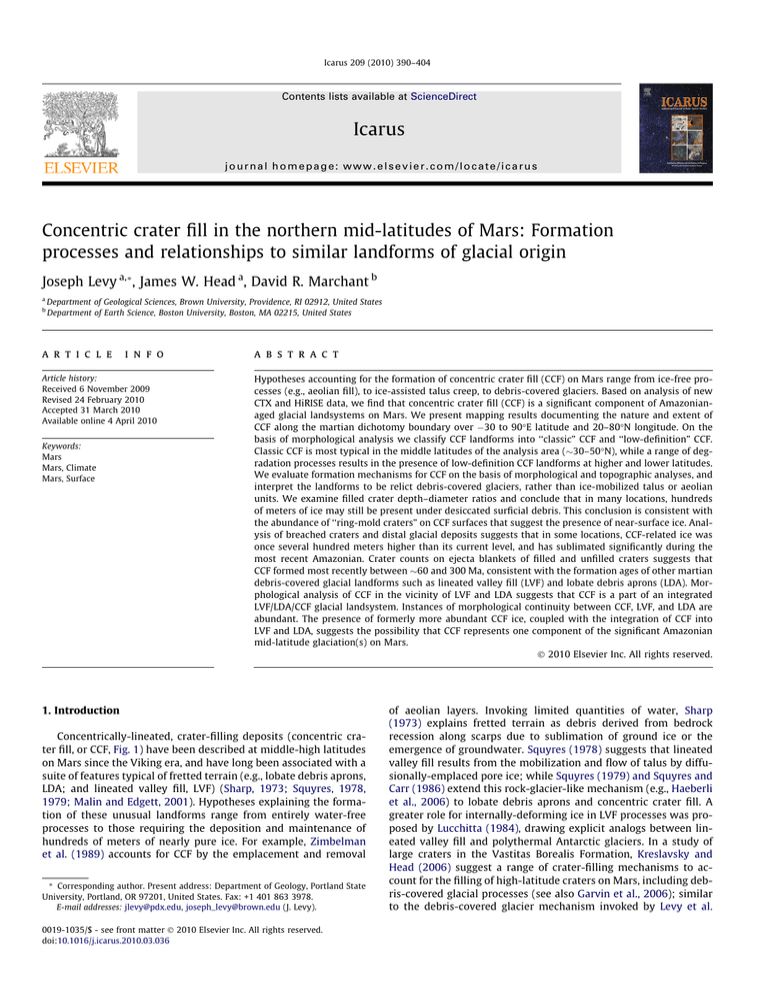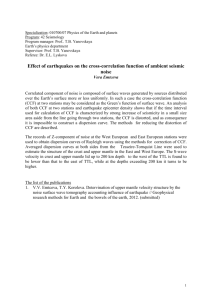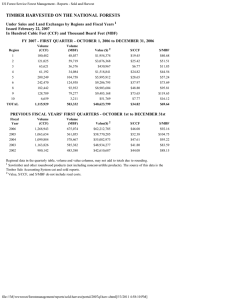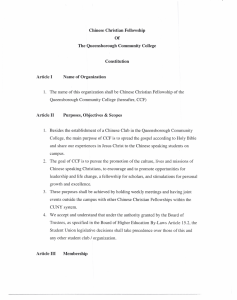
Icarus 209 (2010) 390–404
Contents lists available at ScienceDirect
Icarus
journal homepage: www.elsevier.com/locate/icarus
Concentric crater fill in the northern mid-latitudes of Mars: Formation
processes and relationships to similar landforms of glacial origin
Joseph Levy a,*, James W. Head a, David R. Marchant b
a
b
Department of Geological Sciences, Brown University, Providence, RI 02912, United States
Department of Earth Science, Boston University, Boston, MA 02215, United States
a r t i c l e
i n f o
Article history:
Received 6 November 2009
Revised 24 February 2010
Accepted 31 March 2010
Available online 4 April 2010
Keywords:
Mars
Mars, Climate
Mars, Surface
a b s t r a c t
Hypotheses accounting for the formation of concentric crater fill (CCF) on Mars range from ice-free processes (e.g., aeolian fill), to ice-assisted talus creep, to debris-covered glaciers. Based on analysis of new
CTX and HiRISE data, we find that concentric crater fill (CCF) is a significant component of Amazonianaged glacial landsystems on Mars. We present mapping results documenting the nature and extent of
CCF along the martian dichotomy boundary over 30 to 90°E latitude and 20–80°N longitude. On the
basis of morphological analysis we classify CCF landforms into ‘‘classic” CCF and ‘‘low-definition” CCF.
Classic CCF is most typical in the middle latitudes of the analysis area (30–50°N), while a range of degradation processes results in the presence of low-definition CCF landforms at higher and lower latitudes.
We evaluate formation mechanisms for CCF on the basis of morphological and topographic analyses, and
interpret the landforms to be relict debris-covered glaciers, rather than ice-mobilized talus or aeolian
units. We examine filled crater depth–diameter ratios and conclude that in many locations, hundreds
of meters of ice may still be present under desiccated surficial debris. This conclusion is consistent with
the abundance of ‘‘ring-mold craters” on CCF surfaces that suggest the presence of near-surface ice. Analysis of breached craters and distal glacial deposits suggests that in some locations, CCF-related ice was
once several hundred meters higher than its current level, and has sublimated significantly during the
most recent Amazonian. Crater counts on ejecta blankets of filled and unfilled craters suggests that
CCF formed most recently between 60 and 300 Ma, consistent with the formation ages of other martian
debris-covered glacial landforms such as lineated valley fill (LVF) and lobate debris aprons (LDA). Morphological analysis of CCF in the vicinity of LVF and LDA suggests that CCF is a part of an integrated
LVF/LDA/CCF glacial landsystem. Instances of morphological continuity between CCF, LVF, and LDA are
abundant. The presence of formerly more abundant CCF ice, coupled with the integration of CCF into
LVF and LDA, suggests the possibility that CCF represents one component of the significant Amazonian
mid-latitude glaciation(s) on Mars.
Ó 2010 Elsevier Inc. All rights reserved.
1. Introduction
Concentrically-lineated, crater-filling deposits (concentric crater fill, or CCF, Fig. 1) have been described at middle-high latitudes
on Mars since the Viking era, and have long been associated with a
suite of features typical of fretted terrain (e.g., lobate debris aprons,
LDA; and lineated valley fill, LVF) (Sharp, 1973; Squyres, 1978,
1979; Malin and Edgett, 2001). Hypotheses explaining the formation of these unusual landforms range from entirely water-free
processes to those requiring the deposition and maintenance of
hundreds of meters of nearly pure ice. For example, Zimbelman
et al. (1989) accounts for CCF by the emplacement and removal
* Corresponding author. Present address: Department of Geology, Portland State
University, Portland, OR 97201, United States. Fax: +1 401 863 3978.
E-mail addresses: jlevy@pdx.edu, joseph_levy@brown.edu (J. Levy).
0019-1035/$ - see front matter Ó 2010 Elsevier Inc. All rights reserved.
doi:10.1016/j.icarus.2010.03.036
of aeolian layers. Invoking limited quantities of water, Sharp
(1973) explains fretted terrain as debris derived from bedrock
recession along scarps due to sublimation of ground ice or the
emergence of groundwater. Squyres (1978) suggests that lineated
valley fill results from the mobilization and flow of talus by diffusionally-emplaced pore ice; while Squyres (1979) and Squyres and
Carr (1986) extend this rock-glacier-like mechanism (e.g., Haeberli
et al., 2006) to lobate debris aprons and concentric crater fill. A
greater role for internally-deforming ice in LVF processes was proposed by Lucchitta (1984), drawing explicit analogs between lineated valley fill and polythermal Antarctic glaciers. In a study of
large craters in the Vastitas Borealis Formation, Kreslavsky and
Head (2006) suggest a range of crater-filling mechanisms to account for the filling of high-latitude craters on Mars, including debris-covered glacial processes (see also Garvin et al., 2006); similar
to the debris-covered glacier mechanism invoked by Levy et al.
J. Levy et al. / Icarus 209 (2010) 390–404
391
Fig. 1. ‘‘Classic” and ‘‘low-definition” concentric crater fill (CCF) on the martian dichotomy boundary. (a) Classic CCF. Portion of P15_007028_2164. (b) Low-definition CCF.
Portion of P16_007437_2090. Illumination from the left and north to image top in both images.
(2009b) to account for CCF morphology in Utopia Planitia. The potential for the current presence of significant quantities of ice in
CCF and LVF was suggested by the documentation of abundant
examples of integrated, glacier-like flow features in LVF and LDA
across the martian dichotomy boundary (e.g., Head et al.,
2006a,b, 2010; Levy et al., 2007; Morgan et al., 2009), the presence
of ring-mold craters in LVF/LDA deposits (Kress and Head, 2008),
and the discovery of significant volumes of nearly pure ice within
lobate debris aprons and lineated valley fill described by Holt et al.
(2008) and Plaut et al. (2009) using SHARAD radar data.
Advances in understanding of CCF and related landforms have
followed from the improving spatial resolution and coverage of
spacecraft data, including image and topographic datasets. Here,
we use Context Camera (CTX) (Edgett et al., 2008) and High Resolution Imaging Science Experiment (HiRISE) (McEwen et al., 2009)
image data, coupled with HRSC high-resolution stereo DEMs
(Oberst et al., 2005; Jaumann et al., 2007) and supplemented by
MOLA topographic data, to address the following outstanding
questions related to CCF: (1) What are the morphological characteristics of CCF at high resolution, and what does the morphology
suggest about CCF composition? (2) Are there morphological subtypes of CCF, and if so, what is their geographical distribution? (3)
If ice is involved in CCF processes, is any still present? (4) What is
the relationship between CCF and other crater-filling materials
(e.g., dunes) on Mars? (5) What is the relationship between CCF
and LVF/LDA? (6) What do relationships between LVF/LDA/CCF
processes suggest about the origin and development of martian
glacial landforms? We focus on CCF found along the martian
dichotomy boundary (particularly within 30 to 90°E and 20–
80°N), in the vicinity of a range of landforms that have been interpreted as features of glacial origin.
2. Mapping mid-latitude crater-filling units
Concentric crater fill (CCF) has been classically described in regions containing abundant lineated valley fill (LVF) and/or lobate
debris aprons (LDA) as a crater-interior unit characterized by multiple rings or lineations concentric with the crater rim (Squyres,
1979) (Figs. 1a and 2). At Mars Orbiter Camera (MOC) resolution
(1.5–20 m/pixel), the surface texture associated with LVF, LDA,
and CCF lineations appears mounded and furrowed, a texture described as ‘‘brain or corn-like pit and mound textures” (Malin
and Edgett, 2001), ‘‘pit-and-butte” texture (Mangold, 2003) or
392
J. Levy et al. / Icarus 209 (2010) 390–404
Fig. 2. Comparisons between HiRISE and CTX image data detailing CCF structure at fine and coarse scales. (a) and (c) show the same patch of CCF surface, showing typical
‘‘brain terrain” morphology. HiRISE reveals details of surface structure not visible in CTX images. OC-BT indicates open-cell ‘‘brain terrain” (arcuate and cuspate cells that are
delimited by a convex-up boundary ridge surrounding a flat-floored depression) and CC-BT indicates closed cell ‘‘brain terrain” (arcuate or domed mound features that are
commonly 10–20 m wide, and that may have surface grooves or furrows located near the centerline of the cell’s long axis). LDM Annulus indicates exposures of latitudedependent mantle material ringing the interior of the crater. (b) and (d) show the same CCF-containing crater (areas shown in (a) and (c) indicated by white box). CTX clearly
resolves large-scale lineations in CCF caused by topographic undulation and by orientation of ‘‘brain terrain” cells; HiRISE viewing of the same features show similar structure,
but is noisier due to the resolution of finer-scale features. All images excerpted from CTX image P03_002175_2211 and HiRISE image PSP_002175_2210. Illumination from the
left. North to image top.
‘‘knobs—brain coral” (Williams, 2006). Detailed analysis of HiRISE
images has led to a description of CCF surface texture as ‘‘brain coral terrain” (Dobrea et al., 2007) or ‘‘brain terrain” (Levy et al.,
2009b). For succinctness and consistency, we will refer to this surface texture throughout as ‘‘brain terrain.” HiRISE images reveal
textural differences between ‘‘brain terrain” mounds or ‘‘cells”—
particularly ‘‘closed cells” (arcuate or domed mound features that
are commonly 10–20 m wide, and that may have surface grooves
or furrows located near the centerline of the cell’s long axis) and
‘‘open cells” (arcuate and cuspate cells that are delimited by a convex-up boundary ridge surrounding a flat-floored depression)
(Fig. 2) (Levy et al., 2009b).
Mapping of crater-filling units at martian mid-latitudes can be
accomplished using both HiRISE and CTX image data in concert
(Fig. 3). Full-resolution CTX data are sufficient to resolve broadscale ridges and troughs associated with CCF (Fig. 2), while detailed
analysis of relationships between ‘‘brain terrain” surface textures is
facilitated by observation at HiRISE resolution. Full-resolution CTX
images spanning Mars Reconnaissance Orbiter orbits 1331–7927
from the study region ( 30 to 90°E, 20–80°N) were inspected for
the presence of crater-filling units. Crater-fill units from the 1000
images surveyed were mapped on a sinusoidal equal-area global
map (Fig. 3).
For mapping morphological subtypes, we define ‘‘classic” CCF as
a crater-interior unit showing lineations concentric with at least
some portion of the crater rim and displaying ‘‘brain terrain” surface texture (Fig. 1a). It is the orientation of the long axis of ‘‘brain
terrain” cells that provides the fine structure of CCF lineations
(Fig. 2). Topographic ridges and troughs 100 m wide define the
broader concentric lineations associated with CCF and can be
clearly resolved in CTX image data (Fig. 2) (Levy et al., 2009b).
The distribution of classic CCF along the martian dichotomy
boundary is shown in Fig. 3. In our survey region, classic CCF is
widely distributed between 27°N and 50°N, with scattered
examples at higher and lower latitudes (Fig. 3).
In some craters, CCF lacks clearly defined concentric lineations
produced by topography or lacks clearly-defined ‘‘brain terrain”
cells (Fig. 1b). We refer to this CCF as ‘‘low-definition” CCF. Lowdefinition CCF may show widened fractures or linear depressions
oriented both concentric-with and radial-to the crater rim
(Fig. 1b) or may have a muted surface texture, showing only subtle
stippling or shallow undulations in broad-scale topography. The
latter surface texture is characteristic of higher-latitude low-definition CCF, where continuous latitude-dependent mantle surfaces
are thicker and more widespread (Head et al., 2003; Levy et al.,
2009b). The distribution of low-definition CCF along the dichotomy
boundary is mapped in Fig. 3.
3. CCF morphological relationships
Having briefly outlined the morphological characteristics of
individual CCF deposits, the next step in assessing the origin,
development, and modification history of CCF is to document the
range of stratigraphic and morphological relationships observed
J. Levy et al. / Icarus 209 (2010) 390–404
393
Fig. 3. (Above) Map showing the distribution of CCF landforms along the martian dichotomy boundary. CCF deposits larger than 3 km in diameter are mapped. Six hundred
and fourteen classic CCF deposits are mapped, as well as 262 low-definition CCF deposits. White line indicates region of most concentrated ‘‘classic” CCF detection. Surveyed
image data include all CTX images from orbit groups P01–P17 located in the mapping region spanning 30 to 90°E and 20–80°N. Base map is MOLA topography. (Below)
Histogram comparing the distribution of CCF occurrences (dark bars) and surveyed CTX images (light bars) by 5° latitude bins. CCF distribution appears to be strongly
latitude-dependent, while CTX image distribution is not. CCF occurrences can exceed the number of CTX images in a given latitude bin if multiple examples of CCF are present
in a given CTX image.
between CCF and other martian landforms (e.g., Squyres, 1979;
Squyres and Carr, 1986; Levy et al., 2009b). Here, we consider relationships observed between both ice-related landforms (e.g., LVF,
LDA) (Squyres, 1979; Lucchitta, 1984; Squyres and Carr, 1986;
Head et al., 2006a,b, 2008, 2010; Holt et al., 2008; Levy et al.,
2009b; Plaut et al., 2009) and non-ice-related landforms (such as
talus, craters, and dunes).
3.1. CCF and host craters
Because CCF is a crater-interior unit, relationships between CCF
and its host craters can be used to evaluate CCF-forming processes.
Analysis of image and topography data indicates that CCF does not
merely line or coat the interior of craters; rather it consists of a flat
and high (mesa-like) or convex-up surface that fills host craters
(Fig. 4). Fill thicknesses can be estimated by comparing predicted
crater depths from Garvin et al. (2002) with observed depths from
MOLA or HRSC topographic profiles (e.g., Levy et al., 2009b). Six
measured fill depths vary from 600 m to 1700 m, and commonly constitute 75% of expected crater depth (Fig. 4).
Contacts between CCF material and crater walls have variable
morphology. In some instances, the upper surface of CCF material
sits well above the crater wall and is topographically separated
from the crater wall by a bounding scarp up to 100 m high
(Fig. 4). In other cases, CCF surfaces grade from sloping crater walls
to the CCF surface—this latter relationship is most typical of craters
in which abundant latitude-dependent mantle material rings the
crater interior (Fig. 2) (Head et al., 2003; Levy et al., 2009b).
In some cases, crater-fill material appears to have cross-cut or
transgressed over crater rims (Fig. 5). For example, one crater in
394
J. Levy et al. / Icarus 209 (2010) 390–404
Fig. 4. (a) Classic concentric crater fill that is clearly separated from the interior crater wall talus slopes. White line indicates track of topographic profile. Portion of
P14_006570_2241. Illumination from left. North to image top. (b) HRSC high-resolution DTM topographic profile across CCF-containing crater. Inset shows calculated depth
expected given crater diameter from Garvin et al. (2002) and an idealized bowl-shaped profile.
Deuteronilus Mensae (Fig. 5) shows low-definition CCF within a
crater that is connected to degraded ‘‘brain terrain” surfaces outside the crater by a series of linear, positive-relief ridges. Similar
ridges are present to the east and to the west of the crater. Ridges
to the east of the crater extend from a nearby valley floor, upslope
and onto the outer walls of the crater rim. HRSC topographic profiles of the deposit suggest that the low-definition CCF material is
300 m lower within the crater and outside the crater than it is on
the rim of the crater (Fig. 5). The ridges are morphologically similar
to drop moraines typical of terrestrial glaciers (Marchant et al.,
1993; Benn et al., 2003), as well as martian glaciers (Head and Marchant, 2003; Shean et al., 2005) that form as debris is shed at the
glacier margins. If this interpretation is correct, it indicates that
previously crater-filling material was at least 300 m higher in the
past—sufficient to permit flow over the crater rim and onto the valley floor outside of the crater.
J. Levy et al. / Icarus 209 (2010) 390–404
395
Fig. 5. (a) Low-definition CCF present in a Deuteronilus Mensae crater. ‘‘Brain terrain” surface textures extend out of the crater between several arcuate ridges interpreted to
be moraines. Box shows location of part c. Portion of P16_007385_2149. Illumination from left. North to image top. (b) HRSC high-resolution DTM profile across crater and
nearby plains. (c) ‘‘Brain terrain” knobs present within the distal moraine-like features.
3.2. CCF and dunes
Zimbelman et al. (1989) hypothesized that CCF is an aeolian
feature, primarily on the basis of a layered surface texture visible
in Viking images of ‘‘classic” CCF terrain; what do high-resolution images suggest about crater-filling aeolian processes (e.g.,
sediment and dune deposition)? At both high and low latitudes,
dunes partially fill some craters (Fig. 6). Dunes are seldom present along the entire interior of a crater, and typically drape,
rather than fully fill, the crater interior (Fig. 6). Dune morphology can be readily distinguished from ‘‘brain terrain” textures
in HiRISE and CTX images, suggesting that CCF is not primarily
composed of mobile aeolian material. Rather, higher-resolution
image data reveal that the layered surface texture observed in
Viking image data (Zimbelman et al., 1989) is a visual effect produced by closely-spaced lineations composed of ‘‘brain terrain”
surface texture on topographically undulatory CCF ridges
(Fig. 2) (Levy et al., 2009b).
396
J. Levy et al. / Icarus 209 (2010) 390–404
Fig. 6. Dunes in craters are morphologically distinct from CCF. (a) Typical low-latitude dunes. Illumination from lower left. Portion of P08_004197_2007. Illumination from
left. North to image top. (b) Typical high-latitude dunes. Illumination from lower left. Portion of P16_007187_2581. Illumination from lower left. North to image top.
3.3. CCF and talus
In CTX and HiRISE images, contacts between CCF and talus
slopes are clearly discernable (Fig. 7). Some examples of ‘‘low-definition” CCF (e.g., in Deuteronilus Mensae or Arabia Terra, Fig. 7)
show that ‘‘brain terrain” patterned crater-fill material abuts talus
slopes associated with crater rims. The contact between such talus
slopes and the CCF is abrupt, with CCF material present downslope along a steep scarp. Such relationships are most clearly visible at low latitudes, where annuli of mantling material are not
present at the crater/crater-fill contact (e.g., Fig. 2). Similar contacts between LVF and talus scarps in Nilosyrtis Mensae were
interpreted by Levy et al. (2007) as evidence of the recession of
LVF surfaces from a previous high-stand. This model suggests that
the talus slope was emplaced down to the level of the (previously
higher) LVF margin, and remains as a steep talus slope now that
the LVF/CCF surface has vertically ablated. In other locations, CCF
is topographically separated from the interior slopes of crater walls
by tens to hundreds of meters of relief, suggesting that CCF material is physically distinct from talus shed by crater walls (Fig. 4)
(Russell et al., 2004; Russell and Head, 2005). Lastly, CCF is present
in craters with a range of rim morphologies, ranging from crisp and
relatively well-defined (Figs. 1, 2, and 8) to complexly eroded
(Fig. 9), suggesting that CCF is not simply composed of mobilized
talus shed from crater rims.
3.4. CCF and LVF
CCF and lineated valley fill (LVF) commonly are present in the
same geographical areas on Mars (Squyres, 1979; Squyres and Carr,
1986; Head et al., 2006b, 2010). What do contacts between LVF and
CCF show? In many locations (Figs. 10 and 11), contacts between
CCF and LVF show surficial merging of CCF and LVF lineations.
LVF-containing valleys commonly breach craters hosting CCF, both
from upslope (Fig. 10) and down-slope (Figs. 10 and 11). Merging
of surface lineations occurs in both cases (Head et al., 2006a). HiRISE analysis of ‘‘brain terrain” surface textures on both CCF and LVF
show similar groupings of open and closed cells forming characteristic lineations (Fig. 12). Topographic profiles across LVF/CCF contacts are gradational and smooth in HiRISE image data, and at
both MOLA resolution (460 m/pixel) and HRSC-DTM resolution
(100 m/pixel) (Figs. 10 and 11).
J. Levy et al. / Icarus 209 (2010) 390–404
397
Fig. 7. (a) ‘‘Brain terrain” patterned ‘‘low-definition” CCF surface in contact with a crater central peak talus slope. Crater-fill material is significantly lower than the steep talus
slope. Inset shows higher-resolution view of talus–CCF contact. Portion of P17_007743_2169. Illumination from left. North to image top. A larger view of this crater is found in
Fig. 14. (b) ‘‘Brain terrain” patterned ‘‘low-definition” CCF surface in contact with a crater rim talus slope. Crater-fill material is significantly lower than the steep talus slope.
Box shows location of part c. (c) Higher-resolution view of talus–CCF contact. For (b) and (c), illumination is from the left, and north is towards image top. Portion of HiRISE
image PSP_005752_2130 overlaid on CTX image P17_005752_2130.
3.5. CCF and LDA
3.6. CCF and the LDM
Along with lineated valley fill (LVF), CCF commonly occurs in
the same geographical areas as lobate debris aprons (LDA) (Squyres, 1979; Squyres and Carr, 1986; Head et al., 2006b, 2010). In
some craters, ‘‘brain terrain” surfaced lobes extend from crater
walls, towards the crater interior, but do not entirely fill the crater
(Fig. 13). Lineations on these lobes are commonly concentric with
crater rims. In other craters (Fig. 14), crater-filling material spills
from within the crater down to proximal, LVF-surfaced valley
floors. Such fill is commonly lineated along strike, rather than concentrically with the crater, similar to lineations in lobate debris
aprons (LDA) (Squyres, 1979; Squyres and Carr, 1986; Head et al.,
2006a, 2010; Levy et al., 2007).
What relationships are observed between CCF and the martian
latitude-dependent mantle (LDM) (Kreslavsky and Head, 1999,
2000; Mustard et al., 2001; Head et al., 2003; Milliken et al.,
2003; Levrard et al., 2004)? Relatively low-albedo mantling material typically overlies some portion of CCF surfaces along the
dichotomy boundary (e.g., Fig. 2). This mantling material is commonly polygonally patterned by thermal contraction cracks and
ranges in thickness from <1 m to several tens of meters (Levy
et al., 2009b). This mantling material overlies CCF ‘‘brain terrain”
and shows little evidence of deformation associated with CCF flow,
consistent with a very youthful age of emplacement (1–2 Ma), as
compared to the more ancient CCF (see below) (Levy et al., 2009b).
398
J. Levy et al. / Icarus 209 (2010) 390–404
Fig. 8. CCF with a range of impact crater morphologies. Portion of P17_007585_2149. Illumination from upper left. North to image top. (b) Fresh, bowl-shaped impact crater.
(c) Three ‘‘ring-mold” craters (Kress and Head, 2008).
Fig. 9. CCF in a crater with an extensively eroded rim. Contrast with CCF in craters
with intact rims (e.g., Figs. 1 and 5). Illumination from left. North to image top.
Portion of P16_007385_2149.
4. Age estimates
Crater counting on CCF surfaces poses many of the same challenges as crater counting on LDA and LVF surfaces: small craters
are obscured by ‘‘brain terrain” cells (Levy et al., 2009b) while larger craters may have undergone a range of modification processes
(Mangold, 2003; Kress and Head, 2008). Two principle morphologies of craters are observed on CCF surfaces: fresh, bowl-shaped
craters (Fig. 8a and b) and ‘‘ring-mold” craters (RMCs) (Fig. 8a
and c) that display the same inner ring or inner plateau morphologies described for RMCs on LVF and LDA by Mangold (2003) and
Kress and Head (2008). Both fresh and RMC craters are observed
on CCF surfaces, suggesting a complex geological history for CCF.
In order to provide an age estimate for the formation of CCF, we
avoid counting directly on CCF surfaces. Rather, we identify CTX
images in which both filled (CCF) and unfilled craters are present
(Fig. 15, Table 1). By counting on the ejecta of these craters, it is
possible to bracket the formational period of CCF: the CCF must
have formed after the filled-crater ejecta was emplaced, but before
the unfilled-crater ejecta was emplaced (Fig. 15). Crater counts
were made on 10 impact crater ejecta deposits surrounding comparably-sized craters with and without CCF deposits. The combined crater count results are summarized in Fig. 16. This
binned-count approach assumes that CCF deposits formed at
approximately the same time throughout the study region. Both
counts show significant roll-off at small crater size—in part a resolution effect associated with CTX data and in part due to small-crater resurfacing at high latitudes due to mantle emplacement
processes (e.g., Head et al., 2003; Levy et al., 2009a; Kreslavsky,
2009). Still, counts on unfilled-crater ejecta show a quantitatively
younger age. Best-fit ages calculated using Hartmann (2005) isochrons and only craters larger than 100 m are 70 Ma for unfilled
craters and 320 Ma for CCF filled craters; similar to age estimates
for LDA and LVF that span 0.1–1 Ga (Mangold, 2003; Head et al.,
2006a,b, 2010; Levy et al., 2007; Kress and Head, 2008). Visual
inspection of isochron plots suggest an age for unfilled craters of
60–80 Ma, with filled craters forming a population of surfaces
that may be up to 1 Ga in age. The kink in the filled crater curve
at the 0.5 km diameter bin may be indicative of an older population of craters that has undergone a range of resurfacing processes
(Neukum and Hiller, 1981; Werner, 2009), or the Amazonian filling
of considerably older craters. Both curves indicate, however, that
CCF formation is a process typical of the relatively recent
Amazonian.
5. Discussion
On the basis of the observations presented above, we can evaluate hypotheses regarding the origin and significance of concentric
crater fill (CCF). Given the strong morphological dissimilarity between CCF and landforms identified as dunes, we suggest that
CCF does not represent a purely aeolian crater-filling process.
However, atmospheric processes such as deposition of windblown
J. Levy et al. / Icarus 209 (2010) 390–404
399
Fig. 10. (a) CCF integrated into lineated valley fill (LVF). Surface lineations characteristic of LVF grade into CCF from image right to center, and from CCF back to LVF from
image center to left. Illumination from lower right. North to image left. Portion of P12_005870_2181. (b) MOLA gridded topography data extracted from profile from LVF to
CCF to LVF. A nearly monotonic down-slope profile suggests integration of CCF into LVF. Regional flow patterns in this area were mapped by Head et al. (2006a).
sediment (e.g., Zimbelman et al., 1989) and snow/ice (Head et al.,
2006a,b) may be important in CCF formation (see below). Likewise,
CCF may be modified by aeolian processes, such as dust-devil
redistribution of surface sediment (e.g., van Gasselt et al., 2010,
their Fig. 7). Nonetheless, clear morphological differences exist between CCF surface textures and dunes typical of martian low and
high latitudes (Fig. 6). Although CCF deposits bear a superficial
resemblance to terrestrial seif dunes, dune-fields typically lack
the concentric pattern typical of CCF, and do not display openand closed-cell ‘‘brain terrain” morphology (Levy et al., 2009b).
The observation that CCF is commonly elevated above the interior slopes of craters, and in places is markedly convex-up, suggests that CCF is not simply crater rim talus material that has
been transported down-slope by ice-assisted creep (e.g., Squyres,
400
J. Levy et al. / Icarus 209 (2010) 390–404
Fig. 11. (a) CCF integrated into lineated valley fill (LVF). Surface lineations characteristic of CCF grade into LVF in a confined valley and then into a broader LVF trunk valley.
Illumination from lower right. North to image left. Portion of P04_002653_2216. (b) High-resolution HRSC-DTM profile from CCF to LVF. A nearly monotonic down-slope
profile suggests integration of CCF into LVF.
1979; Squyres and Carr, 1986; van Gasselt et al., 2010). Indeed, CCF
is found on craters with well-preserved rims, as well as craters that
have eroded rims (Figs. 1, 4 and 8–10 respectively). Two key morphological observations are difficult to reconcile with such a rockglacier-like mechanism (Haeberli et al., 2006): (1) recession of CCF
from high stands (implying the removal of a large volume of excess
ice) (Figs. 7 and 2) the presence of convex-up and high-standing
CCF in crater interiors (implying preferential removal of CCF material around crater wall interiors) (e.g., Russell et al., 2004; Russell
and Head, 2005) (Fig. 4). In both instances, internal rock–rock contact in the rock-glacier model for CCF would provide a uniform surface topography, even as interstitial ice was removed from the
J. Levy et al. / Icarus 209 (2010) 390–404
401
Fig. 12. Comparison of similar ‘‘brain terrain” surface textures on CCF (b) and LVF (c). (a) Context image showing CCF integrated with LVF (see Fig. 11). Illumination from the
left. North to image top. (b) Typical CCF ‘‘brain terrain.” Illumination from image bottom. Portion of PSP_008296_2175. (c) Typical LVF ‘‘brain terrain.” Illumination from
image bottom. Portion of PSP_009588_2175.
Fig. 14. Lobate debris apron-like flow emerging from a crater and integrating into
LVF. This feature suggests a similar origin for CCF, LVF, and LDA. Illumination from
left. North to image top. Portion of P04_002442_2221.
Fig. 13. Partial fill of a crater by lobe-like, rim-concentric, ‘‘brain terrain” surfaced
deposits. The partial fill material is similar in position and morphology to lobate
debris aprons observed elsewhere on Mars. Illumination from left. Portion of
P16_007242_2159.
deposit. Rather, these morphological observations suggest that significantly excess ice (ice volume exceeding pore space volume) is
required to form CCF.
What does the presence of landforms that have been interpreted as indicators of debris-covered glacial ice in or on CCF
deposits suggest about the origin of concentric crater fill? Ringmold craters (RMCs) have been interpreted as interactions
between impactors and near-surface ice through spallation and
differential sublimation (Mangold, 2003; Kress and Head, 2008).
‘‘Brain terrain” has been interpreted as the surface expression of
a multi-stage sublimation process in the upper portions of CCF,
LVF, and LDA surfaces, in which fracture and sediment infill drive
differential sublimation of buried ice (Levy et al., 2009b). Finally,
tracing of surface lineations on LVF, LDA, and CCF shows continuity
of flow and folding over multiple-km length-scales, strongly suggesting the internal deformation and flow of an ice-rich substrate
forming these landforms (Head et al., 2006a,b, 2010; Levy et al.,
2007; Dickson et al., 2008; Morgan et al., 2009). Indeed, the presence of topographic ridges and troughs, as well as fractures (both
thermal-contraction-driven and resulting from structural failure
of deforming ice) are typical for terrestrial debris-covered glaciers,
and may form parallel or orthogonal to the flow direction
(Marchant et al., 2002; Head et al., 2006a,b; Levy et al., 2007).
The combined observation of ring-mold craters, ‘‘brain terrain,”
and flow-related lineations on CCF all suggest that CCF is composed
largely of debris-covered ice that underwent flow and has been
modified by sublimation. We interpret CCF to represent craterinterior debris-covered glaciers (e.g., Garvin et al., 2006; Kreslavsky
402
J. Levy et al. / Icarus 209 (2010) 390–404
Fig. 15. Filled and unfilled craters provide a means of estimating the age of CCF
emplacement. The most recent CCF emplacement period must be older than the age
determined by counts on unfilled-crater ejecta and younger than the age
determined by counts on filled-crater ejecta. Illumination from upper left. North
to image upper right. Portion of P06_003272_2079.
Table 1
Index of craters used for crater retention age dating.
Crater type
Image number
Latitude
Longitude
Unfilled
Unfilled
Unfilled
Unfilled
Filled
Filled
Filled
Filled
Filled
Filled
P03_003272_2079
P13_006147_2226
P15_006964_2274
P17_007872_2151
P04_002562_2203
P12_005659_2123
P15_006953_2253
P15_007081_2183
P17_007783_217
P17_007677_2287
28.05°N
41.45°N
48.28°N
35.22°N
40.05°N
34.49°N
44.26°N
40.11°N
43.34°N
47.26°N
34.91°E
21.43°E
33.13°E
82.10°E
23.01°W
26.41°E
26.28°W
79.87°E
8.98°W
4.82°E
Fig. 16. Crater counts for ejecta of CCF filled craters (white circles) and unfilled
craters (black circles). Best-fit ages are 60 Ma for unfilled craters and 300 Ma for
filled craters, suggesting that CCF formed during the recent Amazonian.
and Head, 2006; Levy et al., 2009b) that initially flowed downslope from protected crater-rim accumulation zones (e.g., Fig. 13)
before merging and filling crater interiors (e.g., Fig. 1).
What is the relationship between CCF and other martian glacial
landforms, such as LVF and LDA? The morphological similarity between ‘‘brain terrain” surfaces associated with LDA, CCF, and LVF
suggest that these units have undergone similar developmental
histories. The confluence and merging of CCF, LVF, and LDA lineations suggests that they have similar rheological properties and
were active during the same period. The comparable crater retention ages recorded by CCF, LVF, and LDA suggest that similar processes were involved in the formation and modification of these
units, over the course of the recent Amazonian. A large body of evidence suggests that LVF and LDA formed as debris-covered glaciers
as ice accumulated at high obliquity in protected alcoves along
dichotomy boundary slopes, flowed as cold-based glaciers, and
eventually sublimated as climate conditions grew colder and/or
drier (Forget et al., 2006; Head et al., 2006a,b, 2010; Levy et al.,
2007; Dickson et al., 2008; Madeleine et al., 2009). Morphological
similarities between CCF and LVF/LDA suggest that similar mechanisms may have controlled CCF formation and development. Given
(1) the detection of buried ice beneath martian LDA and LVF (Holt
et al., 2008; Plaut et al., 2009), (2) the thinness of overlying sublimation residue deposits suggested by the presence of ring-mold
craters (Mangold, 2003; Kress and Head, 2008), and (3) the hundreds to thousands of meters of fill material still present in CCF
deposits, we suggest that CCF may represent a significant reservoir
of non-polar martian ice, extending over 38,000 km2 along the
martian dichotomy boundary.
What does CCF morphology indicate about changes in CCF volume over time? The presence of steep talus slopes above some CCF
deposits (e.g., Fig. 7) suggests that in places at least tens of meters
of CCF material has been removed since the cessation of flow. At a
larger scale, the presence of ‘‘uphill flowing” low-definition CCF
deposits (Fig. 5), similar to perched glacier deposits observed in
Coloe Fossae crater interiors (e.g., Dickson et al., 2008, 2009), suggests that in places at least 300 m of CCF material has been removed. The vertical drop-down of CCF surfaces is consistent with
loss of relatively clean glacier ice (Marchant et al., 2002, 2007;
Kowalewski et al., 2006; Marchant and Head, 2007), and is inconsistent with loss of pore ice in grain-supported regolith (e.g., rockglaciers would not result in a change in surface elevation). This
suggests that CCF deposits were once considerably more voluminous than is indicated by their current extent. For many CCF deposits, the presence of an additional 300 m of material would over-fill
the craters that the CCF currently occupy, suggesting along with
the presence of breached CCF craters (e.g., Figs. 5 and 10–12), the
intriguing possibility that CCF deposits were once part of a larger,
inter-crater glacial landsystem (Marchant and Head, 2008, 2009),
remnants of which are preserved as CCF, LVF, and LDA deposits,
along with ice buried beneath mid-latitude pedestal craters (Kadish et al., 2008). If this were the case, then the current extent of
CCF represents only the fraction of the maximum extent of ice that
has been preserved beneath a debris cover as the glaciation waned.
Finally, what is the relationship between CCF and the martian
latitude-dependent mantle (LDM) (Mustard et al., 2001; Head
et al., 2003; Milliken et al., 2003; Levrard et al., 2004)? The difference in age between LVF/LDA/CCF and the LDM by one to two orders of magnitude suggests that they represent distinct periods of
ice deposition on Mars that have left a record of unique characteristic landforms. Young, meters-thick LDM deposits drape CCF, LVF,
and LDA (Levy et al., 2009b)—in places showing limited evidence of
recent deformation as viscous flow features (Milliken et al., 2003).
In contrast, 100 Ma old LVF, LDA, and CCF show evidence of integrated glacier-like flow over tens of kilometers, and to depths of
hundreds to thousands of meters (Forget et al., 2006; Head et al.,
2006a,b, 2010; Levy et al., 2007; Dickson et al., 2008; Madeleine
et al., 2009). Accordingly, the transition over the most recent
Amazonian from widespread deposition of CCF, LVF, and LDA to
J. Levy et al. / Icarus 209 (2010) 390–404
latitude-dependent LDM emplacement may represent a transition
from more active glacial periods to a more quiescent ‘‘ice age” period of martian climate evolution (e.g., Head et al., 2003; Levy et al.,
2009b).
6. Conclusions
On the basis of morphological analyses of concentric crater fill
(CCF) along the martian dichotomy boundary, we conclude that a
debris-covered glacier-like formation mechanism is the most consistent explanation for the current distribution and characteristics
of CCF, rather than ice-mobilized talus creep or purely aeolian processes. Given strong morphological similarities between surface
textures associated with CCF, LVF, and LDA, we suggest that similar
debris-covered glacier processes account for the formation of all
three landforms. Filled crater depth–diameter analysis indicates
that in many locations, hundreds of meters of ice may still be
present under desiccated surficial debris. Analysis of breached
CCF-containing craters suggests that in at least several locations,
CCF-related ice was once several hundred meters higher than its
current level, and has sublimated significantly during the most
recent Amazonian (between 60 and 300 Ma). The presence of
formerly more abundant CCF ice, coupled with the integration of
CCF into LVF and LDA glacial landsystems suggests the possibility
that CCF represents one component of a significant, Amazonianage glaciation of mid-latitude Mars.
Acknowledgments
We gratefully acknowledge support from the Mars Exploration
Program Mars Express HRSC Grant JPL 1237163, and the Mars Data
Analysis Program Grants NNG05GQ46G and NNX07AN95G to
J.W.H. Special thanks to Caleb Fassett for assistance in processing
and interpreting crater count information and for image processing; to James Dickson for coordination of image processing and distribution. The thoughtful comments of two anonymous reviewers
greatly improved this manuscript.
References
Benn, D., Kirkbride, M.P., Owen, L.A., Brazier, V., 2003. Glaciated valley landsystems.
In: Evans, D.J.A. (Ed.), Glacial Landsystems. Edward Arnold, London, pp. 372–
406.
Dickson, J.L., Head, J.W., Marchant, D.R., 2008. Late Amazonian glaciation at the
dichotomy boundary on Mars: Evidence for glacial thickness maxima and
multiple glacial phases. Geology 36, 411–414.
Dickson, J.L., Head, J.W., Marchant, D.R., 2009. Kilometer-thick ice accumulation in
the northern mid-latitudes of Mars: Evidence for crater-filling events in the late
Amazonian at the Phlegra Montes. Earth Planet. Sci. Lett.. doi:10.1016/
j.epsl.2009.08.031.
Dobrea, E.Z.N., Asphaug, E., Grant, J.A., Kessler, M.A., Mellon, M.T., 2007. Patterned
ground as an alternative explanation for the formation of brain coral textures in
the mid latitudes of Mars: HiRISE observations of lineated valley fill textures. In:
7th International Conference on Mars, Pasadena, CA (Abstract #3358).
Edgett, K.S., Malin, M.C., and t.C.S.O. Teams, 2008. MRO context camera (CTX)
investigation primary mission results. In: American Geophysical Union Fall
Meet., San Francisco, CA (Abstract #P31D-04).
Forget, F., Haberle, R.M., Montmessin, F., Levrard, B., Head, J.W., 2006. Formation of
glaciers on Mars by atmospheric precipitation at high obliquity. Science 311
(5759), 368–371.
Garvin, J.B., Sakimoto, S.E.H., Frawley, J.J., Schnetzler, C., 2002. Global geometric
properties of martian impact craters. Lunar Planet. Sci. 33, League City, TX.
Abstract #1255.
Garvin, J.B., Head, J.W., Marchant, D.R., Kreslavsky, M.A., 2006. High-latitude coldbased glacial deposits on Mars: Multiple superposed drop moraines in a crater
interior at 70°N latitude. Meteorit. Planet. Sci., 1659–1674.
Haeberli, W., and 10 colleagues, 2006. Permafrost creep and rock glacier dynamics.
Permafrost Periglacial Processes 17, 189–214.
Hartmann, W.K., 2005. Martian cratering 8: Isochron refinement and the
chronology of Mars. Icarus 174, 294–320.
Head, J.W., Marchant, D.R., 2003. Cold-based mountain glaciers on Mars: Western
Arsia Mons. Geology 31, 641–644.
403
Head, J.W., Mustard, J.F., Kreslavsky, M.A., Milliken, R.E., Marchant, D.R., 2003.
Recent ice ages on Mars. Nature 426, 797–802.
Head, J.W., Marchant, D.R., Agnew, M.C., Fassett, C.I., Kreslavsky, M.A., 2006a.
Extensive valley glacier deposits in the northern mid-latitudes of Mars:
Evidence for late Amazonian obliquity-driven climate change. Earth Planet.
Sci. Lett. 241, 663–671.
Head, J.W., Nahm, A.L., Marchant, D.R., Neukum, G., 2006b. Modification of the
dichotomy boundary on Mars by Amazonian mid-latitude regional glaciation.
Geophys. Res. Lett. 33. doi:10.1029/2005GL024360.
Head, J.W., Marchant, D.R., Kreslavsky, M.A., 2008. Formation of gullies on Mars:
Link to recent climate history and insolation microenvironments implicate
surface water flow origin. Proc. Natl. Acad. Sci. 105, 13258–13263.
Head, J.W., Marchant, D.R., Dickson, J.L., Kress, A.M., Baker, D.M., 2010. Northern
mid-latitude glaciation in the late Amazonian period of Mars: Criteria for the
recognition of debris-covered glacier and valley glacier landsystem deposits.
Earth Planet. Sci. Lett., in press. doi:10.1016/j.epsl.2009.06.041.
Holt, J.W., and 11 colleagues, 2008. Radar sounding evidence for buried glaciers in
the southern mid-latitudes of Mars. Science 322. doi:10.1126/science.1164246.
Jaumann, R., 24 colleagues, and the HRSC Camera Instrument Team, 2007. The highresolution stereo camera (HRSC) experiment on Mars Express: Instrument
aspects and experiment conduct from interplanetary cruise through the
nominal mission. Planet. Space Sci. 55, 928–952.
Kadish, S.J., Head, J.W., Barlow, N.G., Marchant, D.R., 2008. Martian pedestal craters:
Marginal sublimation pits implicate a climate-related formation mechanism.
Geophys. Res. Lett. 35. doi:10.1029/2008GL034990.
Kowalewski, D.E., Marchant, D.R., Levy, J.S., Head, J.W., 2006. Quantifying low rates
of summer-time sublimation for buried glacier ice in Beacon Valley, Antarctica.
Antart. Sci. 18, 421–428.
Kreslavsky, M.A., 2009. Dynamic landscapes at high latitudes on Mars: Constraints
from populations of small craters. Lunar Planet. Sci., The Woodlands, TX, March
23–27. Abstract #2311.
Kreslavsky, M., Head, J., 1999. Kilometer-scale slopes on Mars and their correlation
with geologic units: Initial results from Mars Orbiter Laser Altimeter (MOLA)
data. J. Geophys. Res. 104, 21911–21924.
Kreslavsky, M.A., Head, J.W., 2000. Kilometer-scale roughness on Mars: Results from
MOLA data analysis. J. Geophys. Res. 105, 26695–26712.
Kreslavsky, M.A., Head, J.W., 2006. Modification of impact craters in the northern
plains of Mars: Implications for the Amazonian climate history. Meteorit.
Planet. Sci. 41, 1633–1646.
Kress, A.M., Head, J.W., 2008. Ring-mold craters in lineated valley fill and lobate
debris aprons on Mars: Evidence for subsurface glacial ice. Geophys. Res. Lett.
35. doi:10.1029/2008GL035501.
Levrard, B., Forget, F., Montmessin, F., Laskar, J., 2004. Recent ice-rich deposits
formed at high latitudes on Mars by sublimation of unstable equatorial ice
during low obliquity. Nature 431, 1072–1075.
Levy, J.S., Head, J.W., Marchant, D.R., 2007. Lineated valley fill and lobate debris
apron stratigraphy in Nilosyrtis Mensae, Mars: Evidence for phases of glacial
modification of the dichotomy boundary. J. Geophys. Res. 112. 1029/
2006JE002852.
Levy, J.S., Head, J.W., Marchant, D.R., 2009a. Thermal contraction crack polygons on
Mars: Classification, distribution, and climate implications from HiRISE
observations. J. Geophys. Res. 114. doi:10.1029/2008JE003273.
Levy, J.S., Head, J.W., Marchant, D.R., 2009b. Concentric crater fill in Utopia Planitia:
Timing and transitions between glacial ‘‘brain terrain” and periglacial
processes. Icarus 202. doi:10.1016/j.icarus.2009.1002.1018.
Lucchitta, B., 1984. Ice and debris in the fretted terrain, Mars. J. Geophys. Res. 89,
B409–B418.
Madeleine, J.-B., Forget, F., Head, J.W., Levrard, B., Montmessin, F., Millour, E., 2009.
Amazonian northern mid-latitude glaciation on Mars: A proposed climate
scenario. Icarus. doi:10.1016/j.icarus.2009.1004.1037.
Malin, M.C., Edgett, K.S., 2001. Mars Global Surveyor Mars Orbiter Camera:
Interplanetary cruise through primary mission. J. Geophys. Res. 106, 23429–
23570.
Mangold, N., 2003. Geomorphic analysis of lobate debris aprons on Mars at Mars
Orbiter Camera scale: Evidence for ice sublimation initiated by fractures. J.
Geophys. Res. 108, 8021–8033.
Marchant, D.R., Head, J.W., 2007. Antarctic Dry Valleys: Microclimate zonation,
variable geomorphic processes, and implications for assessing climate change
on Mars. Icarus 192 (1), 187–222. doi:10.1016/j.icarus.2007.06.018.
Marchant, D.R., Head, J.W., 2008. Kilometer-thick ice-sheet in the northern midlatitudes in the Amazonian: Analogs from the East Antarctic Ice Sheet and the
dry valleys. Lunar Planet. Sci. 39, League City, TX. Abstract #2097.
Marchant, D.R., Head, J.W., 2009. The glacial deposits of the northern mid-latitudes:
Remnants of large-scale plateau glaciation. Lunar Planet. Sci. 40, The
Woodlands, TX. Abstract #2355.
Marchant, D.R., Denton, G.H., Swisher, C.C.I., 1993. Miocene–Pliocene–Pleistocene
glacial history of Arena Valley, Quartermain Mountains, Antarctica. Geogr. Ann.
75A, 269–302.
Marchant, D.R., Lewis, A.R., Phillips, W.M., Moore, E.J., Souchez, R.A., Denton, G.H.,
Sugden, D.E., Potter, N.J., Landis, G.P., 2002. Formation of patterned ground and
sublimation till over Miocene glacier ice in Beacon Valley, southern Victoria
Land, Antarctica. Geol. Soc. Am. Bull. 114, 718–730.
Marchant, D.R., Phillips, W.M., Schaefer, J.M., Winckler, G., Fastook, J.L., Shean, D.E.,
Kowalewski, D.E., Head, J.W., Lewis, A.R., 2007. Establishing a chronology for the
world’s oldest glacier ice. Paper presented at 10th International Symposium on
Antarctic Earth Sciences, Santa Barbara, CA.
404
J. Levy et al. / Icarus 209 (2010) 390–404
McEwen, A.S., and 69 colleagues, 2009. The High Resolution Imaging Science
Experiment (HiRISE) during MRO’s primary science phase. Icarus. doi:10.1016/
j.icarus.2009.1004.1023
Milliken, R.E., Mustard, J.F., Goldsby, D.L., 2003. Viscous flow features on the surface
of Mars: Observations from high-resolution Mars Orbiter Camera (MOC)
images. J. Geophys. Res. 108. doi:10.1029/2002JE002005.
Morgan, G.A., Head, J.W., Marchant, D.R., 2009. Lineated valley fill (LVF) and lobate
debris aprons (LDA) in the Deuteronilus Mensae northern dichotomy boundary
region, Mars: Constraints on the extent, age, and episodicity of Amazonian
glacial events. Icarus 202, 22–38.
Mustard, J.F., Cooper, C.D., Rifkin, M.K., 2001. Evidence for recent climate change on
Mars from the identification of youthful near-surface ground ice. Nature 412,
411–414.
Neukum, G., Hiller, K., 1981. Martian ages. J. Geophys. Res. 86, 3097–3121.
Oberst, J., Scholten, F., Gwinner, K., Giese, B., Waehlisch, M., Roatsch, T., Neukum, G.,
2005. The topographic mapping performance of the HRSC (High Resolution
Stereo Camera) on Mars Express. In: American Geophysical Union Fall Meeting,
San Francisco, CA (Abstract #G53C-03).
Plaut, J.J., Safaeinili, A., Holt, J.W., Phillips, R.J., Head, J.W.I., Seu, R., Putzig, N.E.,
Frigeri, A., 2009. Radar evidence for ice in lobate debris aprons in the midnorthern latitudes of Mars. Geophys. Res. Lett. 36. doi:10.1029/2008GL036379.
Russell, P.S., Head, J.W., 2005. Circumpolar craters with interior deposits on Mars:
Polar region geologic volatile and climate history with implications for ground
ice signature in Arabia Terra. Lunar Planet. Sci. 36, League City, TX. Abstract
#1541.
Russell, P.S., Head, J.W., Hecht, M.H., 2004. Evolution of ice deposits in the local
environment of martian circum-polar craters and implications for polar cap
history. Lunar Planet. Sci. 35, League City, TX. Abstract 2007.
Sharp, R.P., 1973. Mars: Fretted and chaotic terrains. J. Geophys. Res. 78, 4073–
4083.
Shean, D.E., Head, J.W., Marchant, D.R., 2005. Origin and evolution of a cold-based
tropical mountain glacier on Mars: The Pavonis Mons fan-shaped deposit. J.
Geophys. Res. 110. doi:10.1029/2004JE002360.
Squyres, S.W., 1978. Martian fretted terrain: Flow of erosional debris. Icarus 34,
600–613.
Squyres, S.W., 1979. The distribution of lobate debris aprons and similar flows on
Mars. J. Geophys. Res. 84, 8087–8096.
Squyres, S.W., Carr, M.H., 1986. Geomorphic evidence for the distribution of ground
ice on Mars. Science 231, 249–252.
van Gasselt, S., Hauber, E., Neukum, G., 2010. Lineated valley fill at the martian
dichotomy boundary: Nature and history of degradation. J. Geophys. Res., in
press. doi:10.1029/2009JE003336.
Werner, S.C., 2009. The global martian volcanic evolutionary history. Icarus 201,
44–68.
Williams, R.M.E., 2006. Latitude dependence of meter-scale surface textures in
Deuteronilus Mensae, Mars. Lunar Planet. Sci. 37, League City, TX. Abstract
#1445.
Zimbelman, J.R., Clifford, S.M., Williams, S.H., 1989. Concentric crater fill on Mars:
An aeolian alternative to ice-rich mass wasting. Paper presented at 19th Lunar
and Planetary Science Conference, Houston, TX.








